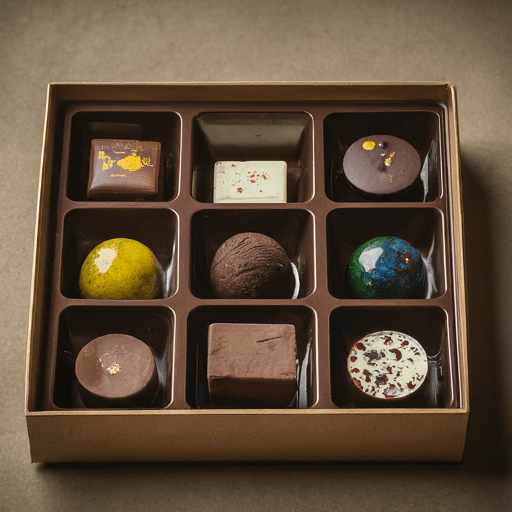Chocolate, a universal symbol of love, luxury, and comfort, tantalizes our taste buds in a multitude of forms. Yet, behind its velvety richness lies a fascinating world of chemistry that transforms mere cocoa beans into the delightful confections we crave. This article peels back the layers of flavor to explore the science that makes chocolate not just a treat for the palate but a marvel to the curious mind. Prepare to embark on a delicious journey through the sweet chemistry of chocolate that ensures you’ll never look at your chocolate bar the same way again!
The Chemistry of Taste: How Chocolate Pleasures Our Palate
Delving into the chemistry of chocolate unveils why it uniquely appeals to our taste sensors. The foundation of chocolate’s irresistible flavor profile lies in over 600 volatile compounds that interact with our taste buds. Among these, theobromine, a bitter alkaloid similar to caffeine but less potent, plays a crucial role in imparting the characteristic chocolate flavor. Unlike caffeine, theobromine offers a smoother, longer-lasting stimulant effect without the jitteriness, making chocolate an addictive delight for many.
Moreover, the fermentation process of cocoa beans is essential for flavor development. During fermentation, natural enzymes and bacteria break down the proteins and sugars within the bean, producing new flavor compounds and reducing bitterness. This process is critical; without it, chocolate would lack its rich depth and nuanced flavors. The specific duration and conditions of fermentation can dramatically alter the final taste, demonstrating how chemistry tailors our chocolate experience.
The sensation of chocolate melting in your mouth also owes to its unique fat composition. Cocoa butter consists of different types of fat molecules that melt near human body temperature. This melting behavior ensures chocolate transforms from a solid to a creamy liquid as soon as it hits your tongue, releasing its flavors rapidly and giving that unmistakable melt-in-your-mouth experience.
Finally, the Maillard reaction – a form of non-enzymatic browning – contributes significantly to taste and aroma during chocolate roasting. Similar to searing steak or toasting bread, roasting cocoa beans causes sugars and amino acids to react, creating rich, complex flavor compounds that define many of chocolate’s comforting and addictive qualities.
The Color Spectrum: Decoding Chocolate’s Hues
The color of chocolate is not merely a trait but a narrative of its cocoa content, processing methods, and quality. Dark chocolate’s rich brown coloration signifies a higher percentage of cocoa solids and less milk and sugar than its paler counterpart, milk chocolate. This intense color correlates with a denser flavor profile and a higher concentration of antioxidants, particularly flavonoids which contribute not just to health benefits but also influence color.
Furthermore, white chocolate stands out with its creamy ivory appearance, owing largely to the absence of cocoa solids – it contains only cocoa butter mixed with milk and sugar. Despite debates about its status as “true” chocolate, its unique color and texture play significant roles in culinary applications. The color variance in white chocolate can also indicate the quality of cocoa butter used, with higher quality yielding a more pristine hue.
Conching, a process where chocolate mass is continuously mixed and aerated, also affects color intensity by promoting even distribution of cocoa butter and breaking down larger particles into finer ones. This process can lighten the appearance of dark chocolate slightly while enhancing its smoothness and glossiness.
Additionally, tempering – carefully controlling heating and cooling of melted chocolate – influences both shine and color. Properly tempered chocolate exhibits a glossy finish and a deeper color due to crystalline structures forming in the cocoa butter. Missteps in tempering can result in bloom, where fat or sugar crystals rise to the surface, creating a whitish cast and altering texture.
The Emotional Chemistry: Why Chocolate Makes Us Feel Good
Beyond taste and appearance, chocolate has an undeniable impact on our mood and emotions – thanks largely to chemistry. Phenylethylamine (PEA), often referred to as the “love drug”, is found naturally in cocoa beans and is known for stimulating feelings akin to falling in love by releasing endorphins and increasing serotonin levels in the brain. This chemical reaction not only enhances mood but also provides a sense of well-being and contentment.
Another key mood-enhancer in chocolate is anandamide, dubbed “the bliss molecule”. This neurotransmitter binds to receptors in the brain similarly to THC (the active ingredient in cannabis), albeit much weaker, promoting relaxation and happiness without psychoactive effects. The presence of anandamide in chocolate could explain why some people turn to it for comfort during stress or sadness.
Magnesium content in dark chocolate is also notable for its potential benefits in combating stress and fatigue. Magnesium plays vital roles in muscle relaxation and nerve function, contributing to overall stress reduction when consumed in moderation as part of a balanced diet.
Lastly, consuming chocolate engages all our senses – sight, smell, taste, touch (texture), even sound (like the snap of a perfectly tempered bar) – creating a multi-sensory experience that triggers positive mental reactions. This comprehensive sensory engagement amplifies the emotional impact of eating chocolate, making it more than just food but an experience that comforts and delights.
Conclusion
From its complex chemistry to its emotional allure, chocolate is more than just a confectionary treat; it’s a fascinating study in science that engages our senses on multiple levels. Understanding the sweet chemistry behind this beloved food enriches our appreciation for each bite, reminding us that behind every delicious morsel lies an intricate dance of molecules responsible for pleasuring our palate and uplifting our spirits. So next time you unwrap your favorite chocolate bar, remember you’re not just indulging in a sweet treat; you’re experiencing a marvel of chemistry in action!
